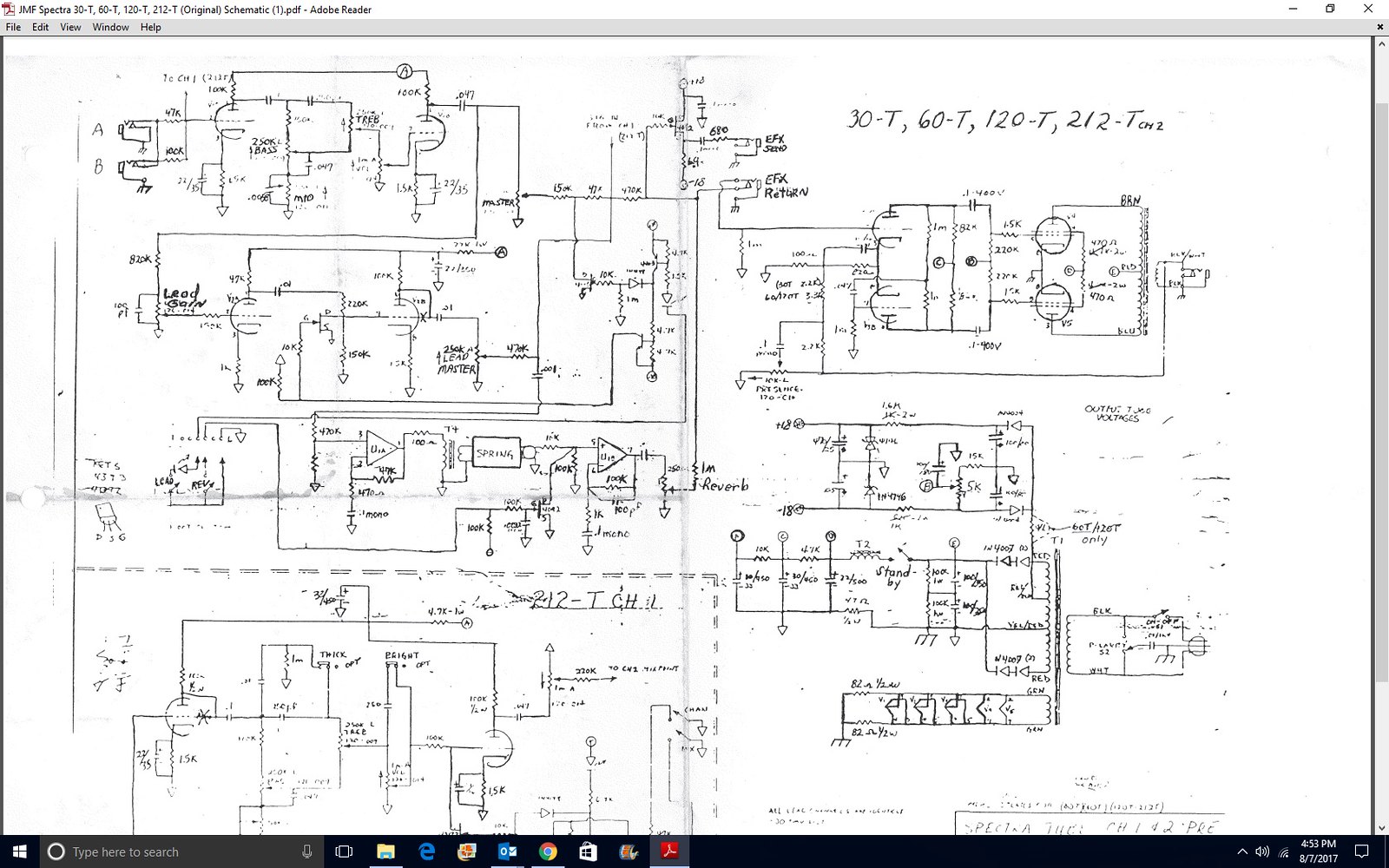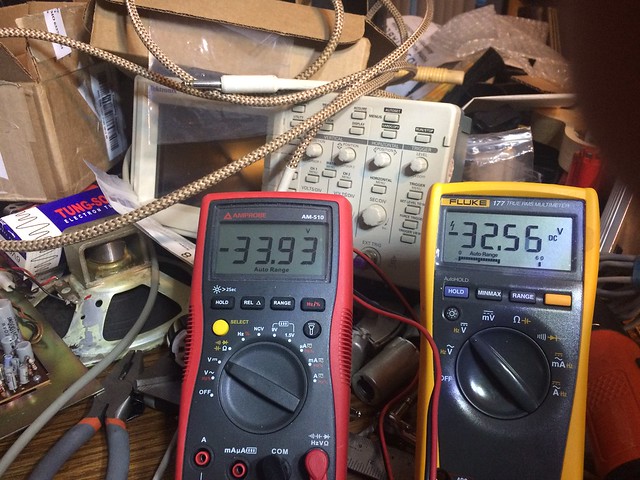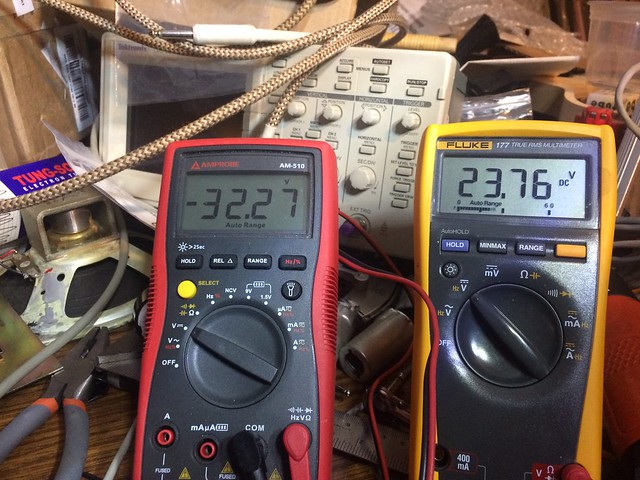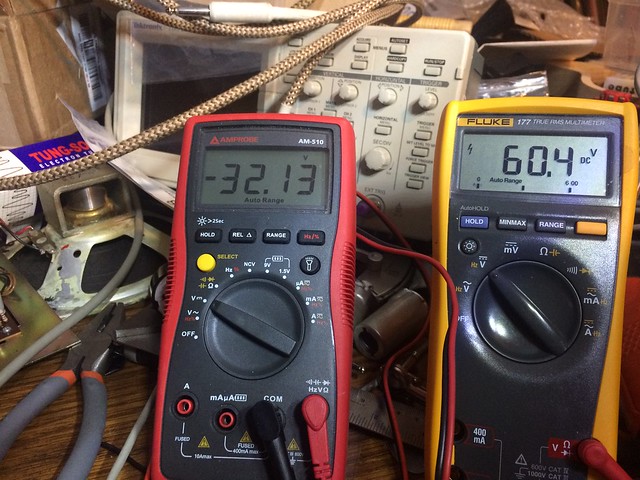I have an old Spectra 30 T that I have been asked to repair. This is a paying gig, so I want to do it right. The initial report is that it overheats and gets really hot after playing loud for about an hour.
I started by measuring the main output tube idle current of the twin 6V6GT tubes. It had a Electro-Harmonics and a Sylvania tube in the output stage. The E-H had a bias current of 19mA, while the Sylvania was 3.5mA? They share the same bias adjustment.
I tried a set of matched Tung-Sol tubes. They both had about 12mA of cathode current. I adjusted the idle current to about 19mA and noted that the adjustment pot was all the way down, from whoever adjusted them before. The amp sounded OK, and I played it for over an hour with no change in idle current, so I was thinking perhaps this was the issue. I informed the owner and he said to go ahead with some new tubes.
The amp has 470 ohm grid resistors, so I decided to measure the voltage and hence the current to subtract it from the cathode current my bias socket measures. The first tube measured almost exactly 1volt, so it has a grid current of 2.1mA. The second tube has zero volts across the 470 ohm resistor? I investigated and found the resistor was fine, the soldering was fine. The problem was that the connector pin inside the tube socket was not making contact, or at least it was intermittent. So an open circuit won't draw any current so the 470 resistor won't have any voltage across it.
I ordered new sockets, but now I am wondering what the effect of this failure mode would be. From what I have seen, it the screen grid is floating it has zero volts so it will shut down? But it's not being forced to be zero volts, it's just floating? I can't really get to the bottom of the tube to measure, at least not easily.
But what would the effect be on the tube and amp if the screen grid resistor was not there? Not shorted, but just not there at all? That is effectively what I have. i don't know my tube theory well enough to answer this, so I was hoping somebody else knows?
I just want to be sure I am on the right track with repairs. And who is to say that there aren't other pins that open up once things heat up, like maybe the bias on the grid? I know if you leave that go open, the the tubes will glow a nice red color like the pair of 7025's I had in a Webcor PA amp, when the bias pot went to an open.
I started by measuring the main output tube idle current of the twin 6V6GT tubes. It had a Electro-Harmonics and a Sylvania tube in the output stage. The E-H had a bias current of 19mA, while the Sylvania was 3.5mA? They share the same bias adjustment.
I tried a set of matched Tung-Sol tubes. They both had about 12mA of cathode current. I adjusted the idle current to about 19mA and noted that the adjustment pot was all the way down, from whoever adjusted them before. The amp sounded OK, and I played it for over an hour with no change in idle current, so I was thinking perhaps this was the issue. I informed the owner and he said to go ahead with some new tubes.
The amp has 470 ohm grid resistors, so I decided to measure the voltage and hence the current to subtract it from the cathode current my bias socket measures. The first tube measured almost exactly 1volt, so it has a grid current of 2.1mA. The second tube has zero volts across the 470 ohm resistor? I investigated and found the resistor was fine, the soldering was fine. The problem was that the connector pin inside the tube socket was not making contact, or at least it was intermittent. So an open circuit won't draw any current so the 470 resistor won't have any voltage across it.
I ordered new sockets, but now I am wondering what the effect of this failure mode would be. From what I have seen, it the screen grid is floating it has zero volts so it will shut down? But it's not being forced to be zero volts, it's just floating? I can't really get to the bottom of the tube to measure, at least not easily.
But what would the effect be on the tube and amp if the screen grid resistor was not there? Not shorted, but just not there at all? That is effectively what I have. i don't know my tube theory well enough to answer this, so I was hoping somebody else knows?
I just want to be sure I am on the right track with repairs. And who is to say that there aren't other pins that open up once things heat up, like maybe the bias on the grid? I know if you leave that go open, the the tubes will glow a nice red color like the pair of 7025's I had in a Webcor PA amp, when the bias pot went to an open.
When the screen grid connection goes open the tube will draw little or no current. This assumes that the tube is reasonably good. A really gassy tube may runaway, but it would already be acting poorly and drawing excessive current.
An open control grid will also cause low or no current on a new tube with an uncontaminated vacuum. NOS tubes are 50 some years old, and many new production tubes have less than stellar vacuum when made, so an open G1 can cause anything from no current to thermonuclear meltdown.
Some amp designs have one end of the bias pot connected to a negative voltage and the other end grounded. If the negative end goes open the tube gets zero volts bias and glows a pretty orange - red color......for a while.
An open control grid will also cause low or no current on a new tube with an uncontaminated vacuum. NOS tubes are 50 some years old, and many new production tubes have less than stellar vacuum when made, so an open G1 can cause anything from no current to thermonuclear meltdown.
Some amp designs have one end of the bias pot connected to a negative voltage and the other end grounded. If the negative end goes open the tube gets zero volts bias and glows a pretty orange - red color......for a while.
I considered that, but tgese look like the are twisted, and maybe even pushed in and down on one side. There is more wrong than just they are too big. I could even get continuity using an ohmeter when I was sure it was in far enough to be touching some metal. I think part of at least that pin's connector is missing.
So what would happen to the other tube? Let's assume this one just turns off. The one that is going still would really be causing an imbalance in the output transformer. Would that cause the OT to saturate?
I am still looking for something that makes the tubes overheat? Unless it is your gassy tube. The Sylvania tube had only 3.5 mA, while the other was 19mA. The Sylvania is the one with the bad socket.
So what would happen to the other tube? Let's assume this one just turns off. The one that is going still would really be causing an imbalance in the output transformer. Would that cause the OT to saturate?
I am still looking for something that makes the tubes overheat? Unless it is your gassy tube. The Sylvania tube had only 3.5 mA, while the other was 19mA. The Sylvania is the one with the bad socket.
It had a Electro-Harmonics and a Sylvania tube in the output stage. The E-H had a bias current of 19mA, while the Sylvania was 3.5mA?......I tried a set of matched Tung-Sol tubes. They both had about 12mA of cathode current.....
EH takes quite a bit of liberty with what they call a 6V6 or a 6L6GC for that matter. It is entirely possible that these two tubes have very little in common and are grossly mismatched. Look at their guts and see if they are built the same.
Try swapping the tubes to see if the high current follows the tube. When there is only one bias adjustment, the tubes should be somewhat matched.....at least of the same brand and construction. It the matched tubes work reliably then the mismatched tubes are your biggest problem.
The one that is going still would really be causing an imbalance in the output transformer. Would that cause the OT to saturate?
Yes, operating the amp with one dead (or otherwise inoperative) tube will cause OPT saturation. This will not affect tube current when no signal is present. Bias measurements should be made with all volume pots all the way down.
It turned out the output transformer was blown on one side. So I replaced it with a Fender Princeton OT, same tubes, similar circuit.
I finally got the transformer and the new sockets installed. It worked even better when I actually hooked the heaters up! Ooops!
I played it for about an hour and it sounded really nice. I set the cathode bias current to 23 ma, and the screen grid resistors have about 1v across the 470 so that puts my bias current rightnaround 21mA of plate current, which is about right for a 408 v plate voltage.
It sounded gret for almost the whole hour and I started cranking it a bit, and I noticed it would ge quiet and then come back?
So I shut it down and put my dual cathose current meters back in and monitored the current. I played it for another 20 minutes and it started farting out again, one of the tubes had the bias current go to about 7 or 10, and jump around, and I got a glimpse of thenother tubes current which was over 100ma, like 170 or 190 or so?
I shut it off as fast as I could find the switch.
So would a leaking or shorting out coupling cap cause this? You normally want -30 vdc on the grid, so if it goes to 150 volts I can see where it might get really a high current through the tube.
I onlynsaw it for a split second. I was focused on the other tube dropping to 7 or 10 mA, so perhaps I didn't really see what I saw? But this amp has cooked a tube socket and an OT so something bad is happening. The bias current going tom7 mA wouldn't account formwhat was bad in the amp. 170mA, yeah, that's a problem.
The coupling cap are orange drop 0.1uF 400v, and I may have replacements. I think I will try just replacing them and leaving thencurrent monitors in place, and maybe add a voltmeter for the B+ or the bias voltage, but that wouldn't explain one tube vs the other.
I finally got the transformer and the new sockets installed. It worked even better when I actually hooked the heaters up! Ooops!
I played it for about an hour and it sounded really nice. I set the cathode bias current to 23 ma, and the screen grid resistors have about 1v across the 470 so that puts my bias current rightnaround 21mA of plate current, which is about right for a 408 v plate voltage.
It sounded gret for almost the whole hour and I started cranking it a bit, and I noticed it would ge quiet and then come back?
So I shut it down and put my dual cathose current meters back in and monitored the current. I played it for another 20 minutes and it started farting out again, one of the tubes had the bias current go to about 7 or 10, and jump around, and I got a glimpse of thenother tubes current which was over 100ma, like 170 or 190 or so?
I shut it off as fast as I could find the switch.
So would a leaking or shorting out coupling cap cause this? You normally want -30 vdc on the grid, so if it goes to 150 volts I can see where it might get really a high current through the tube.
I onlynsaw it for a split second. I was focused on the other tube dropping to 7 or 10 mA, so perhaps I didn't really see what I saw? But this amp has cooked a tube socket and an OT so something bad is happening. The bias current going tom7 mA wouldn't account formwhat was bad in the amp. 170mA, yeah, that's a problem.
The coupling cap are orange drop 0.1uF 400v, and I may have replacements. I think I will try just replacing them and leaving thencurrent monitors in place, and maybe add a voltmeter for the B+ or the bias voltage, but that wouldn't explain one tube vs the other.
If your "orange drops" are paper capacitors (doubtful) they may be leaky and causing the problems. All orange drops I've seen are either polyester or polypropylene and tend to NOT leak, ever.
Do the output tubes have "swamp" resistors on pin 5, usually 1K5 to 10K ohms value. If not, put one on each output tube on pin 5 and attach wire that was on pin 5 to the other side of the resistor. When tube amps are driven very hard, the output tube tends to not see the bias voltage any longer and it will start to redplate. When you stop playing the redness goes away. These "swamp" resistors help eliminate this problem.
If its a leaky cap, the tube would be redplating whenever it's powered on.
Of course the above only applies if it's a fixed bias amp.
I just saw a schematic on google and it looks like there are 1K5 ohm swamp resistors on the amp, if it's the same amp as yours. Change these to 5k6-10K each. Marshall originally used 1k5 resistors on their output tubes and then changed them out for 5k6 resistors because of the same problem that you're having.
Do the output tubes have "swamp" resistors on pin 5, usually 1K5 to 10K ohms value. If not, put one on each output tube on pin 5 and attach wire that was on pin 5 to the other side of the resistor. When tube amps are driven very hard, the output tube tends to not see the bias voltage any longer and it will start to redplate. When you stop playing the redness goes away. These "swamp" resistors help eliminate this problem.
If its a leaky cap, the tube would be redplating whenever it's powered on.
Of course the above only applies if it's a fixed bias amp.
I just saw a schematic on google and it looks like there are 1K5 ohm swamp resistors on the amp, if it's the same amp as yours. Change these to 5k6-10K each. Marshall originally used 1k5 resistors on their output tubes and then changed them out for 5k6 resistors because of the same problem that you're having.
Last edited:
Added schematic
Here is the schematic. Sorry about quality but it's the best I could find.
 Spectra30T by Dennis Kelley, on Flickr
Spectra30T by Dennis Kelley, on Flickr
Here is the schematic. Sorry about quality but it's the best I could find.
 Spectra30T by Dennis Kelley, on Flickr
Spectra30T by Dennis Kelley, on FlickrI got to think something other than a design flaw is bad here. My Fender Princeton has almost the same design, but no resistors at all in that spot. And a Fender Princeton is about as far from a redplating amp as you can get. Although I never really tried to push it much?
I will probably just replace the coupling caps. But then I will monitor the control grid voltage on both 6v6 tubes with them removed. Then I will see if I can get it to go haywire. I'd like to try and fix it without putting 170mA through the 6v6 tube again!
Thanks for the help and advice.
I will probably just replace the coupling caps. But then I will monitor the control grid voltage on both 6v6 tubes with them removed. Then I will see if I can get it to go haywire. I'd like to try and fix it without putting 170mA through the 6v6 tube again!
Thanks for the help and advice.
I GOT YOU SUCKR!
Normal voltages on pin 5 of each tube. This is the bias voltage that sets the idle current through each tube.
 IMG_1614 by Dennis Kelley, on Flickr
IMG_1614 by Dennis Kelley, on Flickr
After about 10 minutes the one on the right started looking a little unsteady? And then it really went crazy.
 IMG_1615 by Dennis Kelley, on Flickr
IMG_1615 by Dennis Kelley, on Flickr
Not its now +23 volts! But it gets better, or worse I guess?
 IMG_1616 by Dennis Kelley, on Flickr
IMG_1616 by Dennis Kelley, on Flickr
OL or overload, means greater than +60V.
 IMG_1620 by Dennis Kelley, on Flickr
IMG_1620 by Dennis Kelley, on Flickr
So lets see the control grid wants -33 and the more positive the more current? I wonder what happens if you give it +60V or more? Ruined tube, ruined tube socket, blown output transformer.
So barring a short in the wires, it must be the coupling cap. The other side of those caps have maybe 250V on them, but it should block it entirely, but it doesnt. It did this and then just went back to -33V as if nothing happened? "What replate?" Its kind of unusual that it is intermittent, but I have seen caps do that too.
Normal voltages on pin 5 of each tube. This is the bias voltage that sets the idle current through each tube.
 IMG_1614 by Dennis Kelley, on Flickr
IMG_1614 by Dennis Kelley, on FlickrAfter about 10 minutes the one on the right started looking a little unsteady? And then it really went crazy.
 IMG_1615 by Dennis Kelley, on Flickr
IMG_1615 by Dennis Kelley, on FlickrNot its now +23 volts! But it gets better, or worse I guess?
 IMG_1616 by Dennis Kelley, on Flickr
IMG_1616 by Dennis Kelley, on FlickrOL or overload, means greater than +60V.
 IMG_1620 by Dennis Kelley, on Flickr
IMG_1620 by Dennis Kelley, on FlickrSo lets see the control grid wants -33 and the more positive the more current? I wonder what happens if you give it +60V or more? Ruined tube, ruined tube socket, blown output transformer.
So barring a short in the wires, it must be the coupling cap. The other side of those caps have maybe 250V on them, but it should block it entirely, but it doesnt. It did this and then just went back to -33V as if nothing happened? "What replate?" Its kind of unusual that it is intermittent, but I have seen caps do that too.
Last edited:
I think it is a metallized polyester
http://www.illinoiscapacitor.com/pdf/seriesDocuments/MSR%20series.pdf
It might be polyproplyene, but it looks the same.
http://www.illinoiscapacitor.com/pdf/seriesDocuments/MSR%20series.pdf
It might be polyproplyene, but it looks the same.
- Status
- This old topic is closed. If you want to reopen this topic, contact a moderator using the "Report Post" button.
- Home
- Live Sound
- Instruments and Amps
- Spectra 30 T, bad socket.